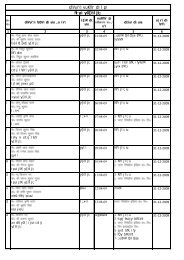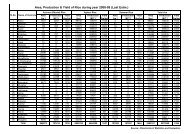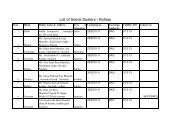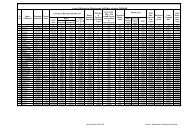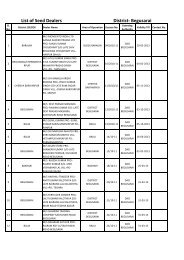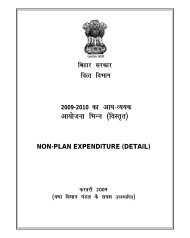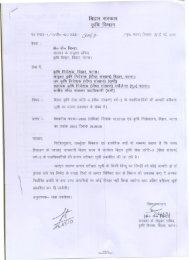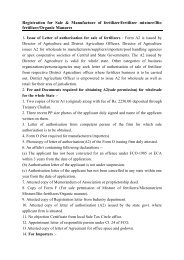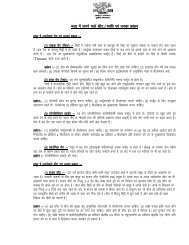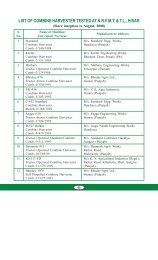chapter v cropping pattern, crop diversification and value addition
chapter v cropping pattern, crop diversification and value addition
chapter v cropping pattern, crop diversification and value addition
You also want an ePaper? Increase the reach of your titles
YUMPU automatically turns print PDFs into web optimized ePapers that Google loves.
The emphasis on foodgrains has another positive implication for Bihar. As reportedearlier, a large proportion of its cultivated l<strong>and</strong> is concentrated in small <strong>and</strong> marginalholdings, <strong>and</strong> foodgrains occupy a significant portion of the l<strong>and</strong> under these holdings. Anemphasis on foodgrains will also help them meet their goal of food security. In <strong>addition</strong>,even the foodgrain <strong>crop</strong>s have ample scope for <strong>value</strong> <strong>addition</strong>. The use of maize used forproducing bio-fuel or starch <strong>and</strong> for other industrial uses is an excellent example ofthis.The scope for <strong>value</strong> <strong>addition</strong> by substituting more suitable <strong>crop</strong>s in different agro-climaticregions needs to be exploited. For example, upl<strong>and</strong> paddy can be replaced by arhar orurad. Wheat can be replaced by winter maize. With the extension of irrigation, currentfallow l<strong>and</strong> can be brought under pulses. The indicative targets for the proposed changes inthe <strong><strong>crop</strong>ping</strong> <strong>pattern</strong> in foodgrains, fruits <strong>and</strong> vegetables, along with their production, areprovided in Tables 5.5 to 5.7.Apart from the fact that dairying is already a widely practised enterprise <strong>diversification</strong>strategy (there is more on this in the next section), small patches of l<strong>and</strong> even on the smallholdings can be devoted to non-foodgrain <strong>crop</strong>s. This is what the farmers in several areasare doing to generate cash incomes. It is important to advise <strong>and</strong> help them selectappropriate non-foodgrain <strong>crop</strong>s. Crops which can contribute to <strong>value</strong> <strong>addition</strong> even on thesmall holdings are maize, horticulture <strong>crop</strong>s <strong>and</strong> vegetables.The main reason for adopting a cautious approach to large-scale <strong>crop</strong> <strong>diversification</strong> is therisk involved in the latter. Even for a limited extent of <strong>crop</strong> <strong>diversification</strong>, it is important tostrengthen marketing linkages as also to ensure easy access to <strong>and</strong> reasonable prices ofstaple foodgrains to the small <strong>and</strong> marginal farmers. There are numerous examples offarmers being pushed to grow some unfamiliar <strong>crop</strong> <strong>and</strong> then left to themselves to findmarkets. Similarly, with inadequate <strong>and</strong> unsatisfactory functioning of the PublicDistribution System (PDS) in foodgrains, the farmers may have to face double jeopardy ifthey ab<strong>and</strong>on foodgrains.5.2 STRATEGY FOR VALUE ADDITION ON SMALL FARMSA multi-pronged strategy for <strong>value</strong> <strong>addition</strong> on the farms, especially on small farms,needs to be adopted <strong>and</strong> the following sub-sections detail the important aspects ofthe proposed strategy.5.2.1 Filling-in Productivity Gaps in the Staple Crops3



